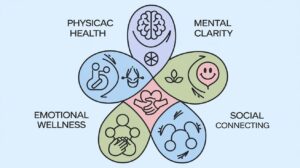10 Steps to Personal Wellness: Your Guide to Holistic Health

While talking about a fast-paced lifestyle in our modern world, much is heard and written about personal wellness and self-care as well as magically maintaining a balance between the two. But what is personal wellness? What makes it different from personal health? And how do we do any things to keep them in our busy lives? In this guide, they will break down the most important elements of personal wellness, how to measure and personalize it, and examine how wellness programs can help.
What Does Personal Wellness Mean?
Personal wellness is a holistic approach to one’s health, which takes into account physical, mental, emotional, and social aspects. It is all about selecting ways of life for preventive measures to keep health in safe, fresh condition and away from illness. Wellness contains a broad conception congregating on all possible physical, mental, and social health features.
Wellness is not a black-and-white affair. What works perfectly for one person may simply not work well for another; thus comes the understanding that in the process of personalizing one’s wellness journey, one must do justice to that person’s life. This can include a personalized wellness plan, or indeed, a wellness journal that tracks goals along the way.
What is Personal Health and Wellness?
Personal health is a subset of wellness and primarily refers to the physical body. It’s the condition of your body at any given time, and it can be influenced by various factors, including genetics, diet, exercise, sleep, and stress levels.
On the other hand, personal wellness is much broader and refers to the overall balance of different dimensions of your life, including:
- Physical Wellness – Maintaining a healthy body through exercise, nutrition, sleep, and preventive care.
- Mental Wellness – Managing stress, emotional well-being, and psychological health.
- Social Wellness – Building and maintaining healthy relationships and social connections.
- Spiritual Wellness – Developing a sense of purpose and meaning in life.
- Environmental Wellness – Living in harmony with your surroundings and contributing to a healthier planet.
How to Maintain Physical Wellness
Physical wellness is often the most visible aspect of personal wellness. It involves caring for your body to ensure you are in good physical condition. Here are some steps to help you maintain physical wellness:
- Regular Exercise: This is one of the most important aspects of physical wellness. Aim for at least 30 minutes of moderate exercise most days of the week, such as walking, swimming, or cycling. If you’re more advanced, strength training and high-intensity interval training (HIIT) can provide even more benefits.
- Balanced Diet: Eating a healthy, balanced diet fuels your body and provides the nutrients it needs. Focus on consuming whole foods like fruits, vegetables, lean proteins, and whole grains, while minimizing processed foods and sugar.
- Hydration: Drink plenty of water throughout the day. Water is essential for maintaining the body’s temperature, removing waste, and lubricating joints.
- Adequate Sleep: Adults should aim for 7-9 hours of sleep per night. Quality sleep helps repair muscles, consolidates memories, and balances hormones.
- Routine Health Screenings: Regular check-ups and preventive care are essential for catching potential health issues before they become serious.
- Stress Management: Chronic stress can affect physical health. Regular relaxation, mindfulness, or meditation can help lower stress levels and improve overall health.
By incorporating these practices into your daily routine, you’ll not only improve your physical health but also contribute to your overall sense of wellness.
Why Wellness is Important in Our Life
Wellness is critical because it affects every aspect of our life, from how we feel physically to how we engage with the world emotionally and socially. Here’s why focusing on wellness is essential:
- Improved Quality of Life: Wellness promotes a better quality of life by reducing the risk of chronic illnesses, improving mood, and increasing energy levels.
- Mental Clarity: When we focus on mental wellness, it reduces anxiety, depression, and stress. Emotional wellness allows us to handle life’s challenges better, fostering resilience and positive thinking.
- Strong Relationships: Social wellness helps us build and maintain strong, meaningful relationships, which are crucial for emotional well-being.
- Enhanced Productivity: When you’re physically and mentally well, you’re more focused, productive, and efficient in your day-to-day activities.
- Longevity: Maintaining good health and wellness can extend your life expectancy, allowing you to live a longer, healthier, and more fulfilling life.
Personalized Well-being: Tailoring Your Journey
Personalized well-being involves customizing your wellness routine based on your unique needs, lifestyle, and goals. This means not just following a generic wellness plan but considering factors like your age, health status, emotional needs, and preferences when crafting your wellness routine.
Here are some ways to personalize your wellness:
- Set Specific Goals: Establish what wellness means to you personally. Do you want to improve your fitness, reduce stress, or enhance your social connections? Set measurable goals that align with your overall well-being.
- Track Your Progress: Consider using a personalized wellness journal to log your activities, moods, nutrition, and workouts. By tracking your progress, you can identify what’s working and make adjustments as needed.
- Adapt to Your Body’s Needs: Personalization means listening to your body. For example, you might find that yoga works better for your mental health, or perhaps running is your key to reducing stress.
-
Integrate Wellness into Your Lifestyle: Personalized well-being is about making choices that fit into your everyday life. Instead of seeing wellness as a rigid routine, think of it as flexible habits you can adapt depending on your schedule or energy levels.
Personalized Wellness Journals: A Tool for Self-Discovery
A wellness journal is an excellent way to monitor and reflect on your well-being journey. By writing down your thoughts, feelings, and behaviors, you can gain insight into what areas of your life need attention and improvement. A personalized wellness journal can track things like:
- Physical Activities: Note your daily exercise routines, how you felt during them, and any progress in your fitness levels.
- Nutrition: Log what you eat and how it impacts your energy and mood.
- Emotional Well-being: Record your mood, stress levels, and any triggers that affect your mental health.
- Gratitude: Writing down things you’re grateful for each day can boost mental health and emotional resilience.
- Sleep Patterns: Track your sleep hours and how rested you feel in the morning.
Regular journaling helps you stay accountable and provides a tangible way to see how far you’ve come on your wellness journey.
How Do Wellness Programs Work?
Wellness programs are designed to support individuals in making healthier lifestyle choices. They can be workplace wellness programs or community-based initiatives, offering various services like fitness classes, nutritional advice, mental health resources, and stress management workshops.
Most wellness programs work by providing:
- Access to Resources: This could include gym memberships, health screenings, or wellness apps.
- Educational Workshops: Many programs offer seminars on nutrition, mental health, and fitness to help individuals make informed decisions about their well-being.
- Group Support: Participating in wellness programs often means joining a community of like-minded individuals who support and motivate each other.
- Incentives: Some workplace wellness programs offer incentives like reduced health insurance premiums or rewards for achieving health goals.
The effectiveness of these programs is often measured by improved health outcomes, such as reduced sick days, increased employee productivity, or better overall well-being of the participants.
How Do You Measure Wellness?
Measuring wellness is a highly individualized process, as wellness looks different for everyone. However, some common metrics include:
- Physical Health Metrics: These include body weight, blood pressure, cholesterol levels, and fitness assessments like endurance, strength, and flexibility tests.
- Mental and Emotional Health: This can be measured through self-assessments or professional evaluations that monitor stress levels, mood, and overall mental clarity.
- Social Health: Social wellness can be gauged by the quality and quantity of your relationships, and whether you feel connected and supported by your community.
- Lifestyle and Habits: Wellness can also be measured by tracking habits like sleep quality, diet, exercise frequency, and screen time. Apps and wearable technology, like fitness trackers, can provide real-time feedback on these factors.
- Self-Reflection: Keeping a wellness journal is one way to regularly assess your emotional and mental well-being.
In Conclusion: Take Control of Your Wellness Journey
Personal wellness is a lifelong journey that involves much more than just physical health. It’s about finding balance in all areas of life—physical, mental, emotional, and social—and personalizing your approach to fit your unique needs and goals. By taking the time to assess your current wellness, setting personalized goals, and incorporating wellness programs into your routine, you can cultivate a healthier, more fulfilled life.
And remember, wellness is not about perfection. It’s about progress and making small, consistent changes that lead to a happier, healthier you. Start today by setting one wellness goal, whether it’s starting a personalized wellness journal or joining a wellness program, and watch how your life transforms for the better.
